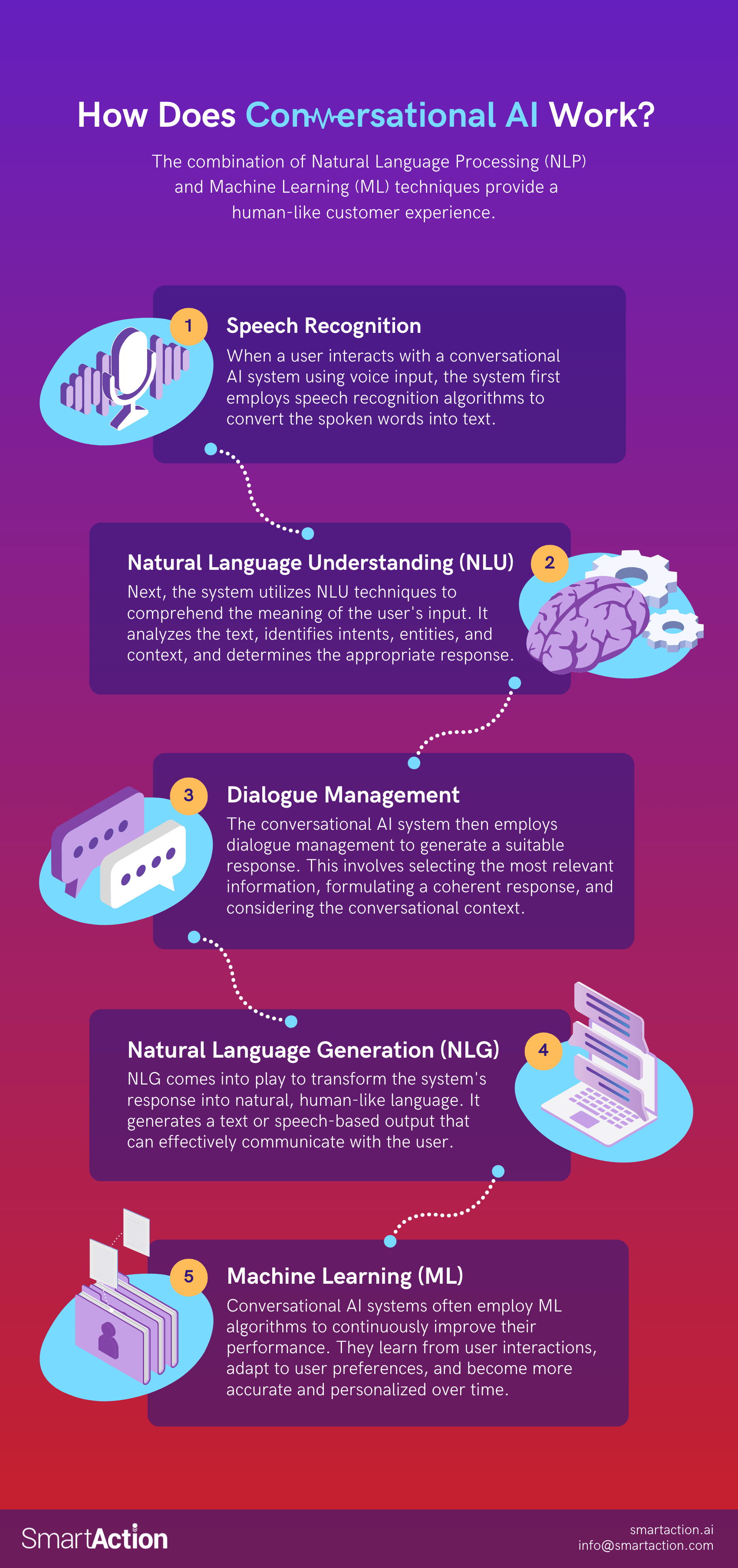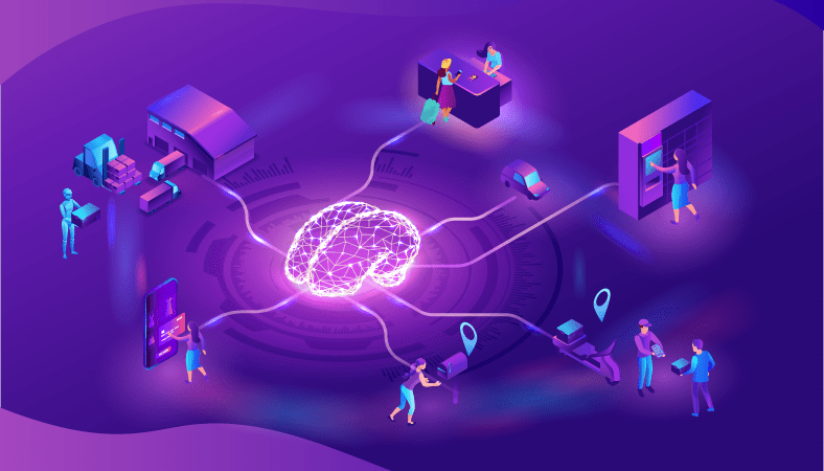What is Conversational AI?
Expectations from customers to be available 24/7 on a variety of channels from voice to social media have driven communication with businesses to evolve beyond traditional interactions. Conversational AI has emerged as the bridge, enabling human-like conversations to help drive and solve customer queries.
Today, conversational AI is everywhere. With lots of coverage and information swirling around, it leads many people to feel overwhelmed by its seeming complexity. Let’s explore this growing technology by understanding what it truly is, reviewing some examples of its applications, diving into its inner workings, and highlighting the associated benefits and challenges businesses and contact centers should consider.
Table of Contents
- What is Conversational AI?
- Examples of Conversational AI
- How does Conversational AI work?
- Benefits and Challenges of Conversational AI
What is Conversational AI?
Conversational AI refers to the integration of artificial intelligence (AI) technologies into computer systems to enable human-like conversations between machine systems and humans. It leverages natural language processing (NLP), machine learning (ML), and other AI techniques to understand, interpret, and respond to human input in a conversational manner.
Systems utilizing these advanced algorithms and deep learning techniques can understand, interpret and respond to human queries. These responses can provide information and assistance, and perform tasks. By engaging in human conversation, conversational AI aims to:
- Enhance user experiences
- Streamline customer engagements with brands
- Enable more efficient and effective communication with consumers
Examples of Conversational AI
There are many applications in which Conversational AI finds itself revolutionizing the way humans interact with technology. Some notable examples include:
Chatbots: Chatbots are AI-powered virtual agents, built in-house or by third-party vendors, that engage in text-based conversations with users. They are widely used in customer support, providing 24/7 assistance. Chatbots often answer FAQs, and guide users through various processes. You may find them on websites, messaging platforms, and mobile apps. Most organizations use them to improve customer experience and reduce human resource costs.
Contact Center Automation: In contact centers, conversational AI can be utilized through a variety of channels to automate routine interactions and assist customer service representatives, with the most robust being voice or IVR systems. AI-powered systems can understand and respond to customer queries, provide relevant information, and even handle basic transactions (or more complex ones with the right platform!), enhancing efficiency and reducing wait times.
Virtual Assistants: Voice-activated assistants like Alexa, Siri, and Google Assistant have become ubiquitous in our daily lives. These virtual assistants leverage conversational AI to understand spoken commands and queries, provide personalized responses and perform tasks like setting reminders, playing music, or searching for information.
Smart Home Automation: Conversational AI enables seamless integration between humans and their smart homes. Voice-controlled systems allow users to control various devices, such as lights, thermostats, and security systems, through spoken commands.
How Does Conversational AI Work?
Conversational AI systems rely on a combination of NLP and ML techniques to understand and generate human-like conversations. Starting with Speech Recognition, then moving on to Natural Language Understanding (NLU) to comprehend the input. Then Dialogue Management starts working to generate a response, and next onto Natural Language Generation (NLG) to transform into a human-like output. And finally Machine Learning (ML) completes the process to become more accurate and personalized over time.
Here’s a simplified overview of the working process:

Benefits and Challenges of Conversational AI
Benefits
- Enhanced User Experience
- Efficiency and Productivity
- Cost Savings
- Self Service
- Increased Sales
Challenges
- Ensuring accuracy and understanding complex inquiries
- Maintaining privacy and data security
- Addressing biases and ethical concerns
- Ongoing Maintenance and Upkeep
Challenges
Ensuring accuracy and understanding complex inquiries
While conversational AI offers many benefits, ensuring accuracy and understanding complex inquiries can present significant challenges. Here are three key challenges:
- Language and Context Understanding: Conversational AI systems need to accurately interpret and understand the nuances of human language to provide meaningful responses. However, language is complex and can be ambiguous, leading to challenges in accurately comprehending user queries. Understanding context, detecting slang, and handling colloquial expressions are a few examples of the linguistic hurdles conversational AI must overcome. Ensuring accurate language understanding requires sophisticated natural language processing (NLP) models and continuous training on vast datasets to improve accuracy and context awareness.
- Handling Complex Inquiries: When faced with intricate questions or unique scenarios, conversational AI often struggles with complex inquiries that go beyond basic FAQs. Chatbots and virtual agents may provide irrelevant or inaccurate responses. This can result in frustration for customers seeking specific information or solutions to their complex problems. Addressing this challenge requires implementing robust knowledge bases and integrating AI models that can handle complex inquiries effectively. It also involves continually improving the system’s ability to recognize complex patterns and provide appropriate responses by leveraging ML algorithms.
- Maintaining Accuracy and Relevance: Changes in product details, pricing, or policies can quickly render chatbot responses outdated. Conversational AI systems need to remain up-to-date and accurate in their responses, especially when dealing with dynamic information. Additionally, conversational AI systems may provide incorrect or incomplete information due to gaps in their knowledge base or limitations in their training data. Maintaining accuracy and relevance requires a well-designed feedback loop where customer interactions are analyzed. Then, the AI system is continuously updated and trained to improve its responses. Regular monitoring, testing, and feedback from users are crucial to identify and rectify any inaccuracies or gaps.
Overcoming these challenges requires advancements in language understanding, handling complex inquiries effectively, and maintaining accuracy and relevance through continuous learning and updating of the AI models. By investing in advanced NLP techniques, knowledge base development, and ongoing system refinement, businesses can improve the accuracy and understanding of conversational AI.
Maintaining privacy and data security
Maintaining privacy and data security can be a significant challenge when it comes to using Conversational AI. Here are three key challenges to be aware of:
- Data Handling and Storage: Conversational AI systems rely on vast amounts of data to understand user queries and provide accurate responses. This data includes customer interactions, personal information, and sometimes sensitive details. Managing and storing this data securely is crucial to ensure privacy and prevent unauthorized access. Businesses must establish robust security protocols to protect user data from breaches, implement encryption mechanisms, and adhere to data protection regulations such as GDPR or CCPA. Additionally, careful consideration must be given to data retention policies to avoid storing unnecessary data for extended periods.
- Consent and Transparency: User data is often collected during conversations. Therefore, businesses must ensure that users are fully aware of how their data is being used. Obtaining explicit consent from users for data collection and providing transparent information about data handling practices is essential. Challenges arise in maintaining clear and concise privacy policies that users can understand easily. Businesses need to be proactive in communicating their data practices, explaining the benefits of conversational AI while assuring users that their privacy is protected. This transparency builds trust and confidence among users, enhancing their willingness to engage with conversational AI systems.
- Integration with Third-Party Services: To provide enhanced functionality, conversational AI systems often integrate with external services and APIs. While these integrations can offer added value, they also introduce potential vulnerabilities and privacy risks. Businesses must ensure that proper security measures are in place when connecting to external systems. This includes conducting thorough security assessments of third-party services, ensuring secure data transmission between systems, and validating the security practices and compliance standards of the service providers. Maintaining control and oversight over the flow of data between the conversational AI system and external services is crucial to protect user privacy and prevent data breaches.
To ensure the safety of their customers, businesses must handle and store data securely, obtain user consent, and ensure transparency in data handling practices. By implementing robust security measures, adhering to privacy regulations, and fostering transparency, businesses can mitigate risks and build user trust in the privacy and security of conversational AI interactions. Prioritizing privacy and data security not only protects users’ information but also helps businesses maintain a positive reputation and loyalty.
Addressing biases and ethical concerns
Addressing biases and ethical concerns inherent in their design and training is something you will want to be thoughtful of when implementing conversational AI. Here are three key challenges you may face:
- Bias in Data and Training: Conversational AI systems learn from vast amounts of data, and if that data contains biases, the AI system can perpetuate and amplify them. Biases can manifest in various forms, such as gender, racial, or cultural biases. It is crucial for businesses to carefully curate and review training data to identify and mitigate any biases present. Additionally, ongoing monitoring and evaluation of AI systems are necessary to ensure that biases are detected and corrected promptly. Addressing bias requires diverse and inclusive datasets, continuous evaluation, and fine-tuning of AI models to minimize unfair or discriminatory outcomes.
- Ethical Decision-Making: Certain situations where ethical decision-making is required, such as handling sensitive or controversial topics, may arise while conversational AI interacts with customers. Determining the appropriate response in such situations poses a challenge. Businesses must define clear ethical guidelines for the AI system. These guidelines should take into account cultural sensitivities, legal requirements, and societal norms. It is essential to strike a balance between providing accurate information and respecting user values and preferences. Transparent communication with users about the limitations of the AI system and the potential biases it may have is also crucial to manage ethical concerns effectively.
- Accountability and Transparency: Businesses should assume accountability for conversational AI systems actions and transparent about their capabilities and limitations. However, achieving transparency in AI algorithms and decision-making processes can be challenging due to their complexity. Businesses need to ensure that AI systems provide clear explanations for their responses when requested, allowing users to understand how the system arrived at a particular conclusion. This promotes trust and allows users to make informed decisions. Additionally, businesses must be transparent about the ownership and usage of data collected during conversations, respecting user privacy rights and providing clear data usage policies.
Addressing biases and ethical concerns in conversational AI can be a complex challenge. It requires careful data curation, ongoing monitoring, and evaluation to minimize biases in AI systems. Establishing ethical guidelines and ensuring transparent decision-making is crucial for responsible AI deployment. Accountability and transparency in AI systems builds trust among users and helps mitigate ethical concerns. By actively addressing biases and ethical considerations, businesses can develop conversational AI systems that promote fairness, inclusivity, and responsible engagement with users.
Ongoing Maintenance and Upkeep
Implementing conversational AI is not a one-time effort but an ongoing process that requires consistent maintenance and upkeep. Doing this within your own organization can take a lot of resources, time and money. When weighing how to approach conversational AI, consider these added costs vs the costs for ongoing support from a vendor.
- Language Evolution and Adaptation: Language is dynamic and continuously evolves, with new words, phrases, and expressions entering the lexicon. Conversational AI systems need to adapt and stay up-to-date with these changes to ensure accurate and relevant responses. This poses a challenge as it requires regular monitoring of language trends, identifying emerging vocabulary, and updating the AI models accordingly. Without ongoing maintenance, conversational AI systems risk becoming outdated, leading to inaccuracies, misunderstandings, and diminished user experience.
- Performance Optimization: Conversational AI systems need to continually improve their performance to meet evolving user expectations and deliver a seamless experience. This involves analyzing user interactions, identifying areas for improvement, and fine-tuning the AI models to enhance accuracy, understanding, and response quality. Performance optimization also includes optimizing response times, minimizing latency, and ensuring smooth integration with other systems. Regular monitoring, testing, and iterative refinement are essential to maintain and enhance the performance of conversational AI systems.
- User Feedback and Iterative Development: User feedback plays a crucial role in the ongoing maintenance of conversational AI systems. Businesses must actively collect and analyze user feedback to identify pain points, areas of improvement, and new use cases. This feedback helps in refining the conversational AI models, addressing gaps in knowledge, and identifying user needs that may have been overlooked initially. Iterative development based on user feedback allows businesses to continuously enhance the system’s capabilities, expand its functionality, and deliver a more personalized and satisfying user experience.
Benefits
Enhanced User Experience
Conversational AI not only streamlines customer service operations but also provides an opportunity to elevate the customer experience. With the ability to instantly respond to queries, offer personalized recommendations, and guide customers through various processes, conversational interfaces create a seamless and user-friendly interaction. Customers appreciate the convenience and efficiency of engaging in natural conversations, enabling them to obtain the information they need quickly and effortlessly.
Many customer support interactions involve information-seeking and repetitive queries. By programming conversational AI systems to handle various use cases, businesses can ensure comprehensive and consistent responses to customers. This fosters continuity within the customer experience, establishing a reliable and efficient support process. Moreover, by automating routine inquiries, valuable human resources can be redirected to address more complex and specialized customer queries, maximizing their expertise and improving overall customer satisfaction.
Efficiency and Productivity
By automating repetitive tasks and delivering instant responses, these systems streamline operations and facilitate seamless interactions. This, in turn, allows live agents to focus on more complex and nuanced conversations that require a human touch. This level of engagement not only enhances the customer experience but also fosters stronger relationships and loyalty.
The time-saving nature of conversational AI also contributes to increased productivity. Customers no longer have to wait in long queues or endure extended response times. Instead, they receive instant and accurate responses, resolving their queries promptly and efficiently. This rapid assistance enhances customer satisfaction and reduces the overall time and effort required to address their needs.
By empowering both customers and employees, conversational AI contributes to a positive feedback loop. Customers benefit from quick and accurate responses, leading to greater satisfaction and loyalty. Employees, on the other hand, are relieved of mundane tasks and can focus on providing exceptional service, leading to higher job satisfaction and reduced turnover rates. This mutually beneficial dynamic creates a virtuous cycle that drives overall productivity and success.
Cost Savings
Traditional approaches to staffing a customer service team can be expensive, especially when catering to inquiries beyond regular office hours. However, with the implementation of conversational AI, businesses can effectively reduce costs associated with salaries and training, making it an invaluable solution. Through chatbots and virtual agents, instant responses and 24/7 availability can be provided, delivering timely assistance whenever customers require it.
One of the primary cost-saving benefits of conversational AI is its ability to automate customer service interactions. By deploying chatbots and virtual agents, businesses can significantly reduce the need for a large workforce to handle routine inquiries. Instead, these AI-powered systems can engage in natural language conversations with customers, understanding their queries and providing accurate responses autonomously. As a result, the need for extensive human staffing can be minimized, leading to substantial cost reductions associated with salaries, benefits, and training.
Consistency in customer support is another area where conversational AI shines. Human interactions may sometimes result in inconsistent responses due to factors such as varying knowledge levels, mood, or interpretation. Conversational AI systems, on the other hand, can be programmed to handle diverse use cases. This can ensure comprehensive and consistent answers to customer inquiries. By maintaining a uniform level of support, businesses can establish trust and confidence while further strengthening their brand reputation.
Expansion of Self-Service
Empowering users through self-service capabilities with AI, allows them to find information, solve problems, and accomplish tasks independently. With the help of chatbots and virtual agents, customers can access a wide range of resources and support without the need for human intervention.
Instead of waiting for human agents or navigating through complex menus, customers can simply initiate a conversation with a chatbot or virtual agent and receive instant responses. This on-demand access to information streamlines the customer experience, enabling users to find answers to their queries quickly and efficiently. Whether it’s checking product details, tracking orders, scheduling an appointment or troubleshooting common issues, self-service capabilities enable customers to take control and obtain the information they need at their own pace.
Customers can engage via various channels, such as messaging platforms, voice assistants, or even embedded within mobile apps or websites. This flexibility allows users to choose their preferred mode of communication, enabling them to seek assistance and access information at their convenience, anytime and anywhere. The self-service aspect of conversational AI puts the power in the hands of users, enabling them to resolve issues and complete tasks autonomously, leading to increased satisfaction and a positive user experience.
Increased Sales
The potential to significantly increase sales by providing personalized and interactive experiences to customers through AI is real. Here are three ways in which conversational AI can be leveraged to drive sales growth:
- Enhanced Customer Engagement: Better understand customer preferences, recommend relevant products or services, and provide tailored assistance throughout the customer journey with chatbots and virtual agents. This personalized engagement not only improves customer satisfaction but also increases the likelihood of making a purchase. Conversational AI can gather customer data, analyze browsing behavior, and leverage machine learning algorithms to offer personalized product recommendations, targeted promotions, and cross-selling or upselling opportunities, thereby driving sales conversion rates.
- Seamless Purchase Experience: Through conversational interfaces, customers can easily inquire about product details, check availability, compare options, and make purchases directly within the chatbot or virtual agents. This seamless experience eliminates the need to navigate multiple platforms or websites, reducing the risk of distractions or abandonment. Conversational AI can integrate with e-commerce platforms, payment gateways, and inventory management systems, enabling customers to make purchases in real time and enjoy a smooth and efficient transaction process.
- Proactive Sales Support: Chatbots and virtual agents can be programmed to initiate conversations with website visitors, offering assistance, and product recommendations based on their browsing behavior. By providing proactive support and personalized recommendations, conversational AI acts as a virtual sales assistant, effectively nurturing leads and driving conversions. This proactive approach not only helps in increasing sales but also enhances customer satisfaction by ensuring that their needs are addressed promptly and effectively.
By leveraging personalized interactions, intelligent recommendations, and streamlined transaction processes, businesses can effectively drive sales growth and improve customer satisfaction. Incorporating conversational AI into sales strategies allows businesses to capitalize on the power of automation and personalization, ultimately leading to improved conversion rates, increased revenue, and long-term customer loyalty.
In Closing…
As conversational AI continues to advance, we can anticipate even more sophisticated systems that possess deeper understanding, better context awareness, and improved natural language generation capabilities. The future holds promising prospects for this technology and will undoubtedly shape the way we communicate in years to come.
Conversational AI is unlocking new frontiers in human-computer interactions, bridging the gap between technology and humans. Its ability to understand and respond to humans has transformed the way we access information, seek assistance, and navigate our digital world. As we move forward, conversational AI will play an increasingly integral role in our lives. Empowering us with enhanced convenience. Energizing us with renewed efficiency. And, engaging us with personalized experiences.

Stop tying up your queues and live agents with repetitive, monotonous tasks. Virtual Agents with SmartAction can let your customers self-service on their time, and free up your live agents to handle more difficult conversations. Let us help take your contact center to the next level through AI voice, text, and chat.
Discover why we’re the top-rated Virtual Customer Assistant solution on Gartner Peer Insights and have been named “The Leader in AI-enhanced Self-Service,” by Frost & Sullivan.
GET IN TOUCH
See How We Can Help You Exceed your CX Goals.
Related Content

WHITEPAPER
The Ultimate Guide to AI Self-Service Without Compromise
With 100+ CAI deployments, gain important insights into self-service with real-world customer examples.

WEBINAR
The Conversational AI Journey: What to Expect from Start to Finish
Get key insights and best practices for implementing AI-powered virtual agents in the contact center.

BLOG
Conversational AI 101: NLU and IVR for Beginners
Discover the basics of conversational AI —natural language understanding, speech detection vs. recognition, and more.






